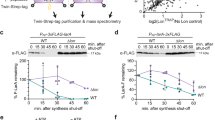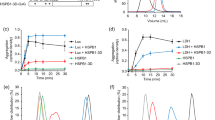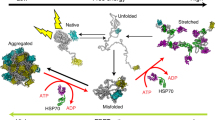Abstract
THE heat-inducible members of the HsplOO (or Clp) family of proteins share a common function in helping organisms to survive extreme stress, but the basic mechanism through which these pro-teins function is not understood1–5. Hspl04 protects cells against a variety of stresses, under many physiological conditions6,7, and its function has been evolutionarily conserved, at least from Saccharomyces cerevisiae to Arabidopsis thaliana25. Homology with the Escherichia coli Clp A protein suggests that Hspl04 may provide stress tolerance by helping to rid the cell of heat-denatured proteins through proteolysis1. But genetic analysis indicates that Hspl04 may function like Hsp70 as a molecular chaperone8. Here we investigate the role of Hspl04 in vivo using a temperature-sensitiveVibrio harveyi luciferase-fusion protein as a test substrate9. We find that Hspl04 does not protect luciferase from thermal denaturation, nor does it promote proteolysis of luciferase. Rather, Hspl04 functions in a manner not previously described for other heat-shock proteins: it mediates the resolubilization of heat-inactivated luciferase from insoluble aggregates.
This is a preview of subscription content, access via your institution
Access options
Subscribe to this journal
Receive 51 print issues and online access
$199.00 per year
only $3.90 per issue
Buy this article
- Purchase on Springer Link
- Instant access to full article PDF
Prices may be subject to local taxes which are calculated during checkout
Similar content being viewed by others
References
Gottesman, S. et al. Proc. natn. Acad. Sci. U.S.A. 87, 3513–3517 (1990).
Parsell, D. A., Sanchez, Y., Stitzel, J. D. & Lindquist, S. Nature 353, 270–273 (1991).
Squires, C. L., Pedersen, S., Ross, B. M. & Squires, C. J. Bact. 173, 4254–4262 (1991).
Squires, C. & Squires, C. L. J. Bact. 174, 1081–1085 (1992).
Kruger, E., Volker, U. & Hecker, M. J. Bact. 176, 3360–3367 (1994).
Sanchez, Y., Taulien, J., Borkovich, K. A., & Lindquist, S. EMBO J. 11, 2357–2364 (1992).
Sanchez, Y. & Lindquist, S. L. Science 248, 1112–1115 (1990).
Sanchez, Y. et al. J. Bact. 175, 6484–6491 (1993).
Escher, A., O'Kane, D. J., Lee, J. & Szalay, A. A. Proc. natn. Acad. Sci. U.S.A. 86, 6528–6532 (1989).
Schroder, H. T., Langer, T., Hartl, F.-U. & Bukau, B. EMBO J. 12, 4137–4144 (1993).
Webster, D. L. & Watson, K. Yeast 9, 1165–1175 (1993).
Skowyra, D., Georgopoulos, C. & Zylicz, M. Cell 62, 939–944 (1990).
Shanen, S. L. et al. Biochemistry 21, 5539–5551 (1982).
Wickner, S., Hoskins, J. & McKenney, K. Nature 350, 165–167 (1991).
Wickner, S., Hoskins, J. & McKenney, K. Proc. natn. Acad. Sci. U.S.A. 88, 7903–7907 (1991).
Langer, T. et al. Nature 356, 683–689 (1992).
Parsell, D. A. & Lindquist, S. A. Rev. Genet. 27, 437–496 (1993).
Feder, J. J., Rossi, J. M., Solomon, J., Solomon, N. & Lindquist, S. Genes Dev. 6, 1402–1413 (1992).
Treco, D. A. in Current Protocols in Molecular Biology (eds Ausubel, F. M., Brent, R. & Kingston, R. E.) 13.1.1–13.1.7 (Wiley, New York, 1989).
Kurtz, S., Gordon, E. & Lindquist, S. L. in Sequence Specificity in Transcription and Translation 611–620 (Liss, New York, 1985).
Laemmli, U. K. Nature 227, 680–685 (1970).
Wright, R. & Rine, J. in Methods in Cell Biology (ed. Tartakoff, A. M.) 473–512 (Academic, New York. 1989).
Byers, B. & Goetsch, L. Meth. Enzym. 194, 602–608 (1991).
van Tuinen, E. & Riezman, H. J. Histochem. Cytochem. 35, 327–333 (1987).
Schirmer, E., Lindquist, S. & Vierling, E. Pl. Cell (in the press).
Author information
Authors and Affiliations
Rights and permissions
About this article
Cite this article
Parsell, D., Kowal, A., Singer, M. et al. Protein disaggregation mediated by heat-shock protein Hspl04. Nature 372, 475–478 (1994). https://doi.org/10.1038/372475a0
Received:
Accepted:
Issue Date:
DOI: https://doi.org/10.1038/372475a0
This article is cited by
-
A deeply conserved protease, acylamino acid-releasing enzyme (AARE), acts in ageing in Physcomitrella and Arabidopsis
Communications Biology (2023)
-
The yeast guanine nucleotide exchange factor Sec7 is a bottleneck in spatial protein quality control and detoxifies neurological disease proteins
Scientific Reports (2023)
-
Amyloid conformation-dependent disaggregation in a reconstituted yeast prion system
Nature Chemical Biology (2022)
-
Modifier pathways in polyglutamine (PolyQ) diseases: from genetic screens to drug targets
Cellular and Molecular Life Sciences (2022)
-
The chaperone HSPB1 prepares protein aggregates for resolubilization by HSP70
Scientific Reports (2021)
Comments
By submitting a comment you agree to abide by our Terms and Community Guidelines. If you find something abusive or that does not comply with our terms or guidelines please flag it as inappropriate.



